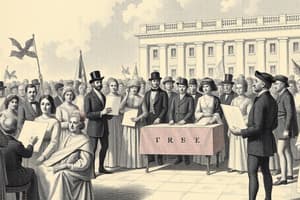Podcast
Questions and Answers
Explain the connection between urbanization and industrialization in relation to democratic reform movements in Britain and France. How did these trends contribute to demands for change?
Explain the connection between urbanization and industrialization in relation to democratic reform movements in Britain and France. How did these trends contribute to demands for change?
Urbanization and industrialization led to significant social and economic changes, creating new problems like poverty, inequality, and worker exploitation. These challenges spurred calls for democratic reforms, as people sought a greater voice in government to address these issues and improve living conditions for the working class.
What were the main goals and demands of the Chartist movement in Britain, and how did their efforts contribute to the broader movement for democratic reforms?
What were the main goals and demands of the Chartist movement in Britain, and how did their efforts contribute to the broader movement for democratic reforms?
The Chartist movement aimed to expand suffrage by demanding the right to vote for all adult males, regardless of property ownership. They also sought other political reforms, such as secret ballots and annual elections. The Chartist movement highlighted the issue of political inequality and contributed to the broader struggle for democratic reform by bringing attention to working-class demands.
Compare and contrast the approaches used by the suffrage movement in Britain and the Dreyfus affair in France. How did their methods and goals differ?
Compare and contrast the approaches used by the suffrage movement in Britain and the Dreyfus affair in France. How did their methods and goals differ?
The suffrage movement in Britain focused on peaceful, legal methods like petitions, public demonstrations, and lobbying Parliament. They sought to expand voting rights to women. The Dreyfus affair in France, however, involved a more confrontational approach, exposing anti-Semitism and military injustice through public protests, debates, and intellectual activism. Their goal was to overturn a wrongful conviction and expose systemic prejudice.
In the context of democratic reforms, discuss the significance of the Third Republic in France. What changes did it bring and how did it impact the French political landscape?
In the context of democratic reforms, discuss the significance of the Third Republic in France. What changes did it bring and how did it impact the French political landscape?
Explain the connection between the Dreyfus affair and the rise of Zionism. How did one influence the other?
Explain the connection between the Dreyfus affair and the rise of Zionism. How did one influence the other?
Identify the historical context of the rise of democratic reforms in Britain and France. What were some of the key factors that contributed to this shift towards greater democracy?
Identify the historical context of the rise of democratic reforms in Britain and France. What were some of the key factors that contributed to this shift towards greater democracy?
What were some of the challenges faced by reformers in both Britain and France as they sought to expand democratic rights and address social inequalities?
What were some of the challenges faced by reformers in both Britain and France as they sought to expand democratic rights and address social inequalities?
While major democratic reforms took place in both Britain and France, were these changes truly transformative? What were some of the limitations and ongoing challenges in achieving full political and social equality?
While major democratic reforms took place in both Britain and France, were these changes truly transformative? What were some of the limitations and ongoing challenges in achieving full political and social equality?
What significant change regarding hereditary peers did the legislation passed in 1999 bring to the House of Lords?
What significant change regarding hereditary peers did the legislation passed in 1999 bring to the House of Lords?
In the early 1800s, what percentage of the British population had the right to vote?
In the early 1800s, what percentage of the British population had the right to vote?
Who were the first group to demand a greater voice in politics leading up to the Reform Bill of 1832?
Who were the first group to demand a greater voice in politics leading up to the Reform Bill of 1832?
What major event in France influenced British parliamentary leaders to pass the Reform Bill of 1832?
What major event in France influenced British parliamentary leaders to pass the Reform Bill of 1832?
How did the Reform Bill of 1832 change property requirements for voting?
How did the Reform Bill of 1832 change property requirements for voting?
What was one aim of the Reform Bill of 1832 regarding representation in Parliament?
What was one aim of the Reform Bill of 1832 regarding representation in Parliament?
Despite the Reform Bill of 1832, what was still true about the voting population?
Despite the Reform Bill of 1832, what was still true about the voting population?
What factors led to the protests in England in favor of the Reform Bill before its passage?
What factors led to the protests in England in favor of the Reform Bill before its passage?
Flashcards
Democratic Reform
Democratic Reform
Changes aimed at improving democracy and increasing citizen participation in government.
Suffrage
Suffrage
The right to vote in political elections.
Chartist Movement
Chartist Movement
A working-class movement in Britain demanding political reforms in the 1830s and 1840s.
Constitutional Monarchy
Constitutional Monarchy
Signup and view all the flashcards
Urbanization
Urbanization
Signup and view all the flashcards
Industrialization
Industrialization
Signup and view all the flashcards
Political Reforms
Political Reforms
Signup and view all the flashcards
Third Republic
Third Republic
Signup and view all the flashcards
British Parliament
British Parliament
Signup and view all the flashcards
House of Lords
House of Lords
Signup and view all the flashcards
House of Commons
House of Commons
Signup and view all the flashcards
Reform Bill of 1832
Reform Bill of 1832
Signup and view all the flashcards
Limited voting rights before 1832
Limited voting rights before 1832
Signup and view all the flashcards
Voting restrictions for women
Voting restrictions for women
Signup and view all the flashcards
Middle class political demand
Middle class political demand
Signup and view all the flashcards
Study Notes
Democratic Reform and Activism
- Urbanization and industrialization spurred demands for reform, leading to calls for improved worker and poor conditions, and greater political voice.
- Different groups (middle class, workers, and women) pushed for voting rights for excluded groups.
- Britain, by the late 1600s, had a constitutional monarchy with Parliament holding real power (House of Lords and Commons).
- Early 1800s British government not a true democracy; only about 5% of the population could vote (landowning men). Women couldn't vote.
British Enacts Reforms
- The Reform Bill of 1832 addressed wealthy middle-class demands for greater political inclusion, expanding suffrage to property-owning middle-class men by easing property requirements and modernizing electoral districts.
- The Reform Bill increased voting numbers (still only a limited percentage of men were eligible) but didn't allow all men to vote.
- The Chartist movement arose as a response to the limited voting rights; advocating for working class demands (secret ballot, end to property requirements for serving in Parliament, pay for members of Parliament.)
Women Get the Vote
- By the 1890s, several industrialized nations had universal male suffrage, but no country allowed women to vote.
- Women organized and protested for voting rights in Britain and the U.S.
- Emmeline Pankhurst formed the Women's Social and Political Union (WSPU) in Britain to take more radical action to gain women's rights.
France and Democracy
- The Third Republic, established in France in 1875, finally provided France with a stable government after a series of crises.
- The Dreyfus affair highlighted anti-Semitism and political divisions in France during the late 1800s and 1890s.
Self-Rule for British Colonies
- Canada, Australia, and New Zealand developed demands for greater self-governance.
- Initially, European colonists dominated Native American peoples in these colonies.
- Canada struggled for self-rule due to conflicts between French and English-speaking colonists. Conflicts were resolved by the creation of Upper and Lower Canada.
- The Durham Report (1839) recommended unifying the colonies as a step toward self-governance.
- Australia was established as a penal colony, initially for convicted criminals from Britain.
- Australia's population grew steadily throughout the 1800s.
- Both Australia and New Zealand eventually achieved self-governance and were later granted dominion status.
The Irish Win Home Rule
- Irish people sought home rule (local control over internal matters), particularly after the Great Famine (1845-1848), which saw potato crop failures, starvation, and widespread emigration.
- British opposition arose due to fears of Protestant minority status under potential Catholic majority rule.
- The Home Rule Bill, enacted in 1914, was delayed due to World War I.
- The Irish Republican Army (IRA) rose in opposition of British rule and fought for a period of time.
- Ireland was divided, with Southern Ireland gaining home rule (later, independence) and Northern Ireland remaining part of the United Kingdom.
Studying That Suits You
Use AI to generate personalized quizzes and flashcards to suit your learning preferences.




